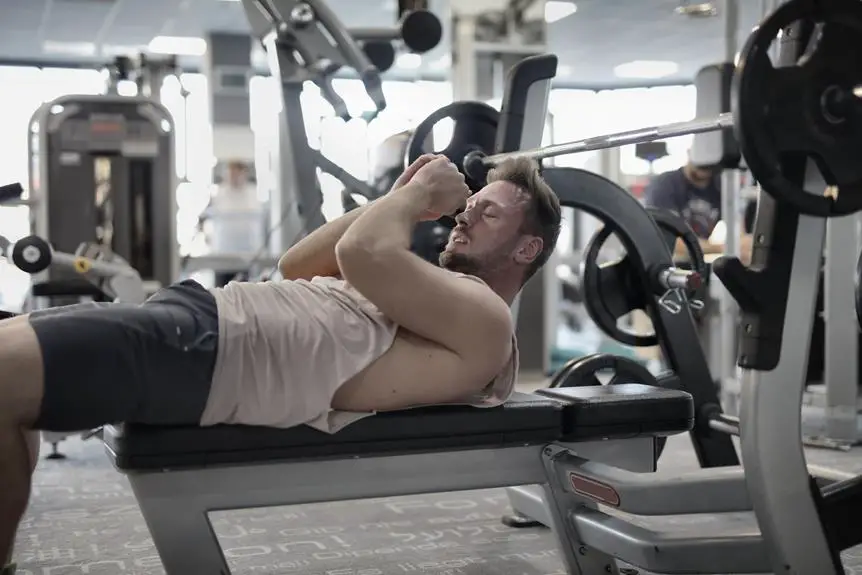An analysis of statistics concerning weightlifting sheds light on the current state of strength training habits among American adults. The data reveals a significant gap between recommended muscle-strengthening activities and actual participation rates, with a considerable portion of the population falling short of established guidelines.
Moreover, disparities based on gender and workout preferences further underline the complexities within weightlifting trends. As we explore average weights lifted by beginners, common injuries faced by lifters, and the popularity shifts in weightlifting, a deeper understanding of the nuances and challenges in this fitness realm begins to emerge.
Key Takeaways
- Beginners typically lift around 75-115 pounds in bench press, squats, and deadlifts.
- Injury prevention in weightlifting is crucial due to risks like strains and rhabdomyolysis.
- Recovery strategies involve rest, nutrition, and rehabilitation exercises to aid in healing.
- Weightlifting participation rates globally show room for growth, especially among women.
Average Weight Lifted by Beginners
In the realm of weightlifting, beginners typically begin their journey by lifting an average weight of around 75 pounds in the bench press exercise. This foundational lift not only builds upper body strength but also serves as a benchmark for assessing progress in weightlifting.
Moving on to squats, beginners usually start with an average weight of 95 pounds. Squats are a fundamental compound exercise that targets multiple muscle groups, emphasizing lower body strength and overall stability.
Deadlifting, another essential lift in weightlifting, often kicks off for beginners with an average weight of 115 pounds. Deadlifts are renowned for their ability to strengthen the posterior chain, including the lower back, glutes, and hamstrings.
Beginners in weightlifting commonly set goals to incrementally increase their lifting capacity over time. This gradual progression is key to building strength effectively and avoiding plateaus.
Proper form and technique are emphasized for beginners not only to optimize performance but also to prevent injuries that can hinder progress in the long run. By starting with manageable weights and focusing on technique, novice lifters can lay a solid foundation for their weightlifting journey.
Common Injuries Experienced by Lifters
Common injuries are a prevalent concern among weightlifters, ranging from strains to severe illnesses like rhabdomyolysis. It is crucial for lifters to prioritize proper form and avoid lifting weights that exceed their capabilities to prevent serious injuries.
Overtraining and insufficient rest periods also contribute to the risk of common weightlifting injuries, emphasizing the importance of recovery strategies and injury prevention techniques in weightlifting routines.
Injury Prevention Tips
To minimize the risk of weightlifting injuries, lifters must prioritize proper form, gradual progression, and guidance from certified trainers. Common weightlifting injuries such as strains, sprains, fractures, and rhabdomyolysis can occur due to factors like improper form or lifting weights beyond one's capacity.
Rhabdomyolysis, a severe condition resulting from muscle breakdown, poses a risk for extreme lifters and can lead to kidney damage. By incorporating proper warm-up routines, stretching exercises, and utilizing correct lifting techniques, individuals can significantly reduce the likelihood of sustaining weightlifting injuries.
Seeking supervision from a certified trainer is crucial as they can provide valuable insights on technique and help in gradually increasing workout intensity, ultimately aiding in injury prevention.
Recovery Strategies for Lifters
Recovery strategies for lifters following common weightlifting injuries encompass a blend of adequate rest, tailored nutrition, and targeted rehabilitation exercises. Injuries such as strains, sprains, fractures, and rhabdomyolysis are prevalent among weightlifters. Adequate rest is crucial for the body to heal and recover from the stress of lifting weights.
Proper nutrition, including sufficient protein intake, helps support muscle repair and growth. Targeted rehabilitation exercises assist in strengthening the affected muscles and improving flexibility to prevent future injuries. Overtraining and improper form are common contributors to weightlifting injuries, including severe conditions like rhabdomyolysis, which results from excessive muscle breakdown.
Seeking guidance from a qualified trainer and being mindful of one's body's cues are essential in preventing and managing lifting-related injuries.
Impact of Overtraining
Excessive training without adequate rest and recovery in weightlifting often results in a variety of injuries that can significantly impact a lifter's physical well-being. Overtraining can lead to common injuries such as strains, fractures, and sprains. Intense training without proper rest and recovery can result in severe muscle strains and tears.
Rhabdomyolysis, a serious condition caused by muscle breakdown, can occur due to excessive weightlifting. Pushing beyond one's limits in weightlifting can increase the risk of overuse injuries like tendonitis. Additionally, overtraining may also lead to chronic conditions like joint pain and inflammation, affecting long-term lifting performance.
It is crucial for lifters to prioritize rest, recovery, and proper training techniques to prevent these injuries and maintain their overall well-being.
Strength Training Gender Disparities
In strength training, gender disparities are evident in the performance and preferences of exercises between men and women. Men tend to excel in exercises like the bench press, where they outperform women by 30%, and barbell curls, where their performance exceeds women's by 71%. On the other hand, women show a higher engagement in exercises such as the leg press, favoring it 42% more than men, and hip thrusts, where their preference surpasses that of men by a significant 830%.
While both genders commonly incorporate bench press, squat, and deadlift into their routines, variations in specific exercises favored by men and women are notable. Despite the popularity of these exercises, there remains a notable gender disparity in weightlifting participation, with only 20% of women engaging in weight training, in contrast to the 80% who do not. Additionally, women's lower testosterone levels play a role in muscle building, allowing them to engage in resistance training without the concern of becoming overly bulky.
Bench Press Statistics
When considering bench press statistics, it is crucial to focus on key points such as:
- Bench press techniques
- Record lifts data
- Injury prevention tips
Understanding the proper form and execution of the bench press is essential for maximizing strength gains and minimizing the risk of injury. Additionally, tracking record lifts can provide motivation and a sense of accomplishment in weightlifting progress.
Bench Press Techniques
Mastering proper bench press techniques is essential for maximizing the benefits of this popular weightlifting exercise that targets the chest, shoulders, and triceps. When performing the bench press, ensure you are using the correct form to prevent injury and optimize muscle engagement.
Here are key points to remember:
- Position: Lie flat on the bench with your feet planted firmly on the ground.
- Grip: Grab the barbell with hands slightly wider than shoulder-width apart.
- Movement: Lower the barbell to your chest in a controlled manner, then press it back up.
- Breathing: Inhale as you lower the barbell and exhale as you push it back up.
Following these techniques can help you improve your bench press performance and overall strength.
Record Lifts Data
Achieving remarkable feats of strength, weightlifters continually push the boundaries of human performance in bench press competitions. The current world record for the bench press stands at an astounding 1,102 pounds, a record set by Julius Maddox in 2019.
In powerlifting competitions, participants are required to lower the barbell to their chest and then press it back up to lockout for the lift to be considered successful. To ensure fair competition, bench press competitions are categorized into different weight classes, allowing lifters to compete against others with similar body weights.
Various organizations and federations establish specific rules and regulations for bench press competitions to maintain consistency and fairness, making record lifts a pinnacle of achievement in the sport.
Injury Prevention Tips
In the realm of weightlifting statistics, a critical aspect that cannot be overlooked is the implementation of effective injury prevention strategies specifically tailored for bench press exercises.
Proper form and technique play a vital role in preventing injuries during the bench press. Additionally, having a spotter present can help avoid accidents. Gradually increasing weight, staying within one's capacity, and avoiding overexertion are key factors in reducing the risk of injuries.
Warm-up sets and stretching before bench pressing can also aid in preventing strains and muscle tears. Incorporating rotator cuff exercises and shoulder mobility work into your routine can further help in preventing shoulder injuries while performing the bench press.
Squat Statistics
Squat statistics provide valuable insights into the average one-rep maximum weights achieved by men and women, showcasing the strength standards and performance levels associated with this fundamental exercise. On average, men achieve a one-rep max of around 120 kg in squats, highlighting the strength and power they can generate. In comparison, women achieve an average one-rep max of approximately 70 kg, demonstrating their strength and capabilities in this compound movement.
Squat strength standards are often tied to body weight, serving as a benchmark for progress and performance evaluation. This approach helps individuals track their development and set realistic goals based on their own body composition and strength levels. Squats target various muscle groups such as the quadriceps, hamstrings, and glutes, making them a cornerstone in strength training routines.
Proper squat technique is paramount for injury prevention and optimizing exercise effectiveness. By mastering the correct form, individuals can reduce the risk of injuries and ensure maximum muscle engagement during squats. Overall, squats enhance lower body strength, stability, and functional movement patterns, contributing to a well-rounded fitness regimen.
Deadlift Statistics
Deadlift statistics offer valuable insights into the average one-rep maximum weights achieved by individuals, showcasing the strength standards and performance levels associated with this compound exercise.
- The average one-rep max for men in the deadlift is around 150 kg, while for women, it is approximately 89 kg.
- Deadlift strength standards are often based on body weight for both men and women to assess performance levels.
- Deadlifting is a compound exercise that targets multiple muscle groups simultaneously, making it a popular choice for strength training.
- Proper form and technique are crucial in deadlifting to prevent injuries and maximize muscle engagement during the lift.
Deadlifts are known to improve overall strength, particularly in the lower body, back, and core muscles, contributing to functional fitness and performance. Understanding these statistics can help individuals set realistic goals, track their progress, and ensure they are training effectively to enhance their deadlifting capabilities.
Weightlifting Popularity Trends
Weightlifting has been steadily gaining traction as a popular form of strength training among a significant percentage of adults globally. In the US, only 30.2% of adults meet muscle-strengthening activity guidelines, indicating a substantial portion of the population engaging in weight training activities.
Globally, approximately 20% of adults participate in weightlifting, showcasing a notable interest in this form of exercise. However, statistics from 2004 showed that only 17.5% of women and 21.9% of men trained strength twice a week, highlighting a disparity in participation based on gender. Surprisingly, just one in five women partake in weightlifting, indicating a potential area for growth and increased female representation in the sport.
Despite more Americans taking part in strength training, the numbers still fall below the desired 30% goal, suggesting a need for further promotion and education regarding the benefits of weightlifting.
Conclusion
In conclusion, statistics on weightlifting reveal a concerning trend of low participation rates in strength training activities among American adults. Despite an increase in gym memberships, a significant portion of the population still falls below recommended muscle-strengthening goals.
Gender disparities in strength training participation also persist, with women lagging behind men in weightlifting activities. It is crucial for individuals to prioritize strength training to improve overall health and fitness levels.








